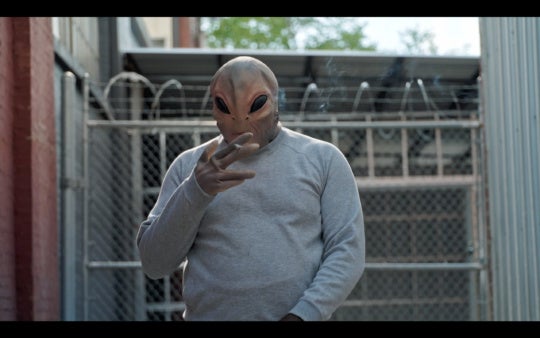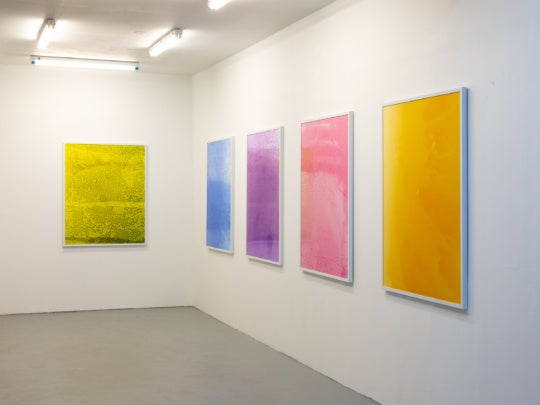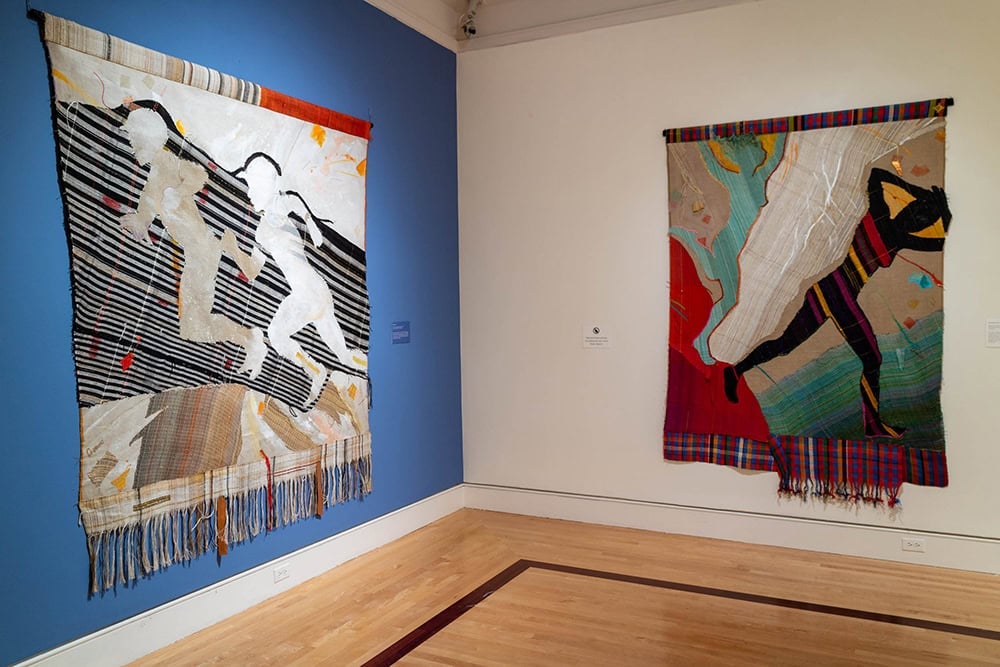
Deeply embedded within its capacity to engage social relations and aesthetic ideologies, color is a remarkable phenomenon because of its multivalence. Its varied utility lends itself to and beyond “purely” formalist concerns, provocatively disclosing, as much as it may also conceal or exemplify, a politics of identity. Seemingly empowered by this sense of multiplicity, color and its relationships is central in the retrospective of Emma Amos (1937-2020) at the Georgia Museum of Art in Athens. Emma Amos: Color Odyssey, curated by Dr. Shawnya Harris, features nearly 60 works created over more than five decades of Amos’s career—exploring autobiography, feminism, race, gender, power and art institutions—via paintings, textiles, installations, and printmaking. This emphasis upon color odyssey argues for attention to Amos’s purposeful, long-term but hard-won professional journey and embraces how her deliberate use of color yields visceral experiences of seeing.
The retrospective framework of the exhibition enables opportunities to engage Amos’s complex personhood, which is crucial to highlight now that a platform exists—compelling long overdue recognition of her career. Care in presentation begins immediately through clear curatorial interest in balancing the iconic with the unrenowned at the entrance. Before entry into the first gallery, visitors are greeted by generative wall text and Seated Figure and Nude (1966), which counts among Amos’s most iconic oil paintings for her approach of chromatically figuring women in space, visually scaffolds the exhibition’s introduction on the main wall by reiterating color’s multivalence. Amos, a painter, printmaker, and textile designer, enlisted the expressiveness of color in order to merge its formal association as a hue with psychosocial notions attached to color and racialized identity. As quoted in the exhibition, Amos remarked “the terms used in describing painting have always held double meanings for me. We’re always talking about color, but colors are also skin colors and the term ‘colored’ itself–it all means something else to me.”
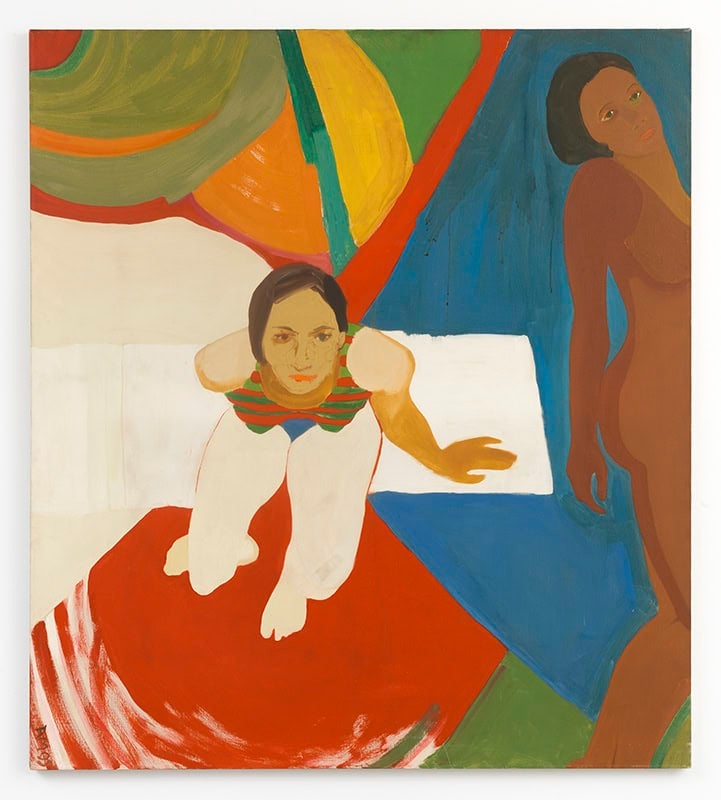
Political and metaphorical connotations buried in color associations anchor most work on view through a host of personal memories and iconographic references that envision diverse, integrated possibilities and realities. The first gallery features large scale paintings alongside etchings such as Poor Lady (1980), as well as silkscreens, and stenciled prints. Sandy and Her Husband (1973), which depicts a quiet embrace between Amos’s wedded friends, blends abstraction and figuration by containing color within the body and domestic objects. Their intimate moment is undisturbed as the couple seems oblivious to any onlooker, including Amos who voyeuristically gazes on from a wryly inserted self-portrait. More references to events and people are culled from Emma Amos’s life, which lends credence to the value of biography despite suspicions of biography’s overdetermining effects. But because Amos loaded her work with family history, racial identity, romantic relationships, friendships–aestheticizing the everyday and history–the exhibition convincingly and easily justifies the centrality of her biography.
Born in 1937 in Atlanta to a college-educated, middle-class Black family noted first for co-owning the Amos Drug Store on the city’s west side and second for welcoming intellectuals from W.E.B Du Bois to Zora Neale Hurston into their social spaces, Amos became acutely aware of the gulf between the public’s stereotypical view of Black life and her lived reality. Moving beyond Black Atlanta, Amos worked primarily in New York City and New Jersey, doubling down as an artist focused on critique, sisterhood, broader art markets and communities. Over time, Amos became known for feminist challenges to patriarchy and white privilege in the art world having famously asserted that, as a Black woman artist, “to walk into the studio is a political act.”
Subsequent works represent a developing politics. In one example, Take One (1985-1987), created in protest as interactive tear-off-sheets of a subjugated female for Art Against Apartheid (a multiracial coalition of artists), concludes the first gallery, which then transitions into energetic paintings, installations, icons in history, and reused family archives. Connections between work like 22 and Cheetah from 1983, an acrylic painting composed of handwoven fabric likely honoring the athletic prowess of the Portland Trail Blazers’ Clyde Drexler, to works like Equals (1992) and Work Suit (1994) are feminist inquiries into self-invention, power and citation. The wall label for 22 and Cheetah directs viewers’ attention to Amos’s gaze towards the identity of male athletes, noting that Amos desired “[stealing] male power.”
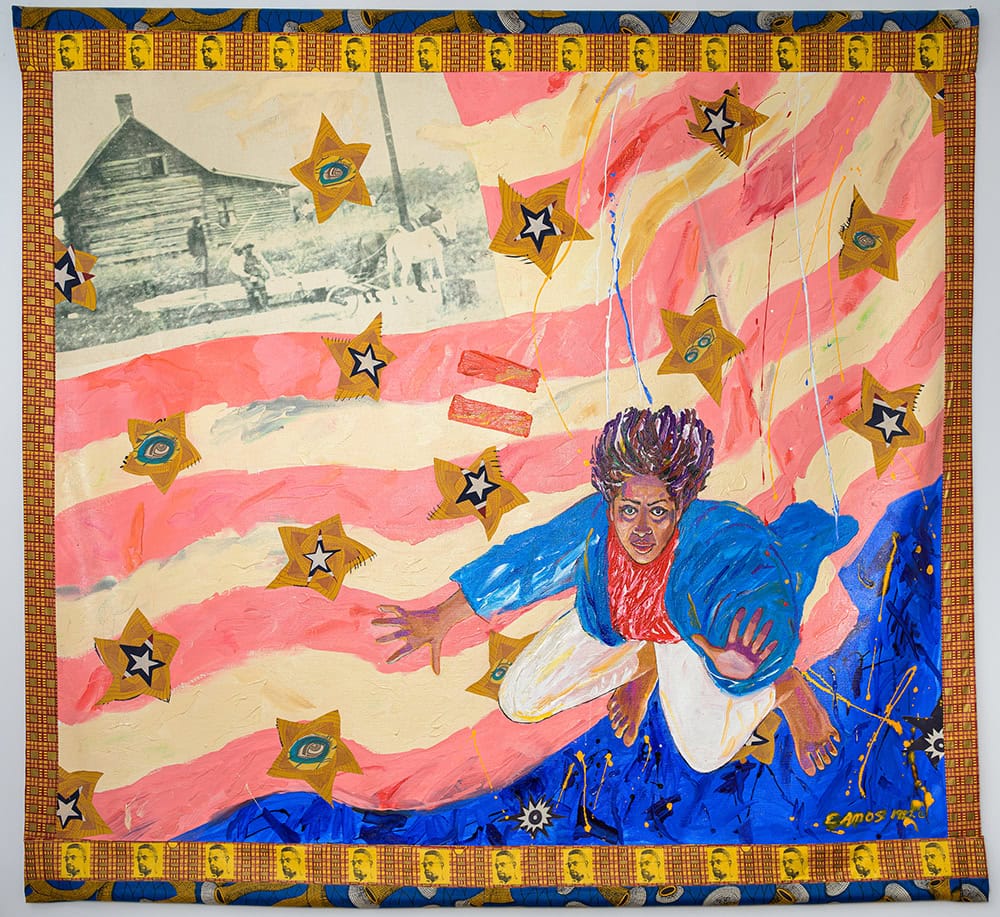
Featuring herself heroically flying (or falling) towards the surface’s foreground capped by two parallel horizontal borders of Malcolm X’s face in Equals, Amos heightens the intensity of contradictory ideals about democracy and equality in the US. A Black woman artist’s existence, but especially their ability to thrive, undermines definitions of artists as white and male, a direct result of structured inequality and access. Amos’s interest in absorbing “male power,” then, goes beyond issues with professional categories to deepened concern with sexist discrimination. A painting like Work Suit, wherein Amos’s painter’s smock is a wry appropriation of Lucian Freud’s self-portrait. Using all but his head, hands and feet, Amos proposes an elective identity keen to wield male power and its authority—a gaze enacted upon the alert white female nude whose stylization recalls Amos’s falling (or flying) figures in movement.
Although Emma Amos: Color Odyssey is a retrospective, a sense of finality is absent. Paired with its exhibition catalogue, additional questions about the politics of seeing and being seen emerge–affording time for honor and praise but also critical inquiry. If perspective and the perception of color is weighted by conversations about race and identity, art and representational politics, figuration and abstraction (among many more), how might unpacking decisions about hue and value, or shade and tint, broach the problematics of colorism without fixing terms of race and color, bodies and genders? What do we envision as one of many ends to Amos’s color odyssey?

